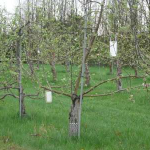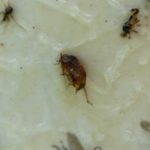Warm weather over the weekend advanced bud stages, pretty much everything in the Champlain and Connecticut Valleys are at green tip and some orchards are bordering on half-inch green. If you haven’t gotten copper out yet, now is the time, tomorrow (Tuesday 4/18)v looks like a good day wind-wise. We’re also out of any frost risk for the foreseeable future (but not necessarily done for the season so don’t plant out your tomatoes), so you can apply oil any time. At this point I would apply 2% (volume/volume) oil and soak it down real well with 100+, preferably 200 gallons of water per acre. After tight cluster, 1% oil should be used to avoid phytotoxicity.
As temperatures cool down this week, bud development will also slow. However, scab ascospores will continue to mature and by mid-week we can expect 5% or more of ascospores to be available for release during the expected rains and wetting events. This is another reason to cover your trees Tuesday prior to the rain. If you put on a full copper rate Friday or later, you are probably good for now, but if you had spotty coverage or have had substantial bud development, and therefore emergence of new susceptible tissue, since you sprayed, then another preventative fungicide may be called for.
Insect activity is generally pretty quiet now, but tarnished plant bug will start to move as days warm up. This would be a good week to get trapes up for this insect pest. We recommend four white sticky traps per block hung knee high in a visible location, often at the block edges. Traps should be checked at least weekly and treatment for TPB considered if over threshold. Thresholds are variable based on tolerance for cosmetic damage- for apples marketed wholesale, three bugs per trap before tight cluster or five before pink bud would warrant treatment; for retail and pick-your-own orchards, the recommended treatment threshold is five and eight bugs per trap, respectively, for those bud stages. TPOB and other insects managed at pink are usually treated with a synthetic pyrethroid material and that is still the recommendation. In order to conserve wild pollinators, we do not recommend use of neonicotinoid insecticides before petal fall.
1Tarnished plant bug trap (lower left) in tree. Right picture: TPB on trap.
Where trade names or commercial products are used for identification,
no discrimination is intended and no endorsement is implied.
Always read the label before using any pesticide.
The label is the legal document for the product use.
Disregard any information in this message if it is in conflict with the
label.
The UVM Tree Fruit and Viticulture Program is supported by the
University of Vermont Agriculture Experiment Station, a USDA NIFA E-IPM
Grant, and USDA Risk Management Agency Funds.


